Numerical Simulation of Thermal Conductivity and Thermal Stress in Lightweight Refractory Concrete with Cenospheres
Abstract
:1. Introduction
2. Materials and Methods
- Effective porosity (also known as open porosity) is described by the total volume of open pores in CAC-based solid concrete filled with resin (Figure 3b).
2.1. Theoretical Foundations of Heat Transfer: Thermal Conductivity and Thermal Stress
2.2. Analytical Methods for the Transfer of Heat and Effective Thermal Conductivity of Porous Materials
2.3. Finite Element Method Based on the Numerical Model in COMSOL
3. Results
- Homogeneous model;
- One-particle model of the composite;
- Model of two particles of the composite.
3.1. Homogeneous Models
Calcium Aluminate Cement, Aluminosilicate Cenospheres, and Air
- Model of homogeneous material 1 (MHM1): the shell of the aluminosilicate cenosphere;
- Model of homogeneous material 2 (MHM2): calcium aluminate cement;
- Model of homogeneous material 3 (MHM3): the air inside the aluminosilicate cenosphere.
3.2. Models of Composites 1, 2, and 3
4. Discussion
5. Conclusions
- Numerical, experimental, and theoretical analyses of the thermal properties of porous lightweight refractory concrete were performed. The studied sample was investigated as the combination of a calcium aluminate cement matrix, with the addition of aluminosilicate cenospheres being the main factor in a considerable reduction in thermal conductivity.
- The simplified representation of the sample’s microstructure was obtained based on scanning electron microscopy testing. The geometrical characteristics of cenospheres—shape, dimensions, and complexity of the particle shell—were evaluated and transferred to the modeling part.
- A finite element scheme was employed to determine the thermal properties at the microscopic scale—effective thermal conductivity and thermal stresses. Simulations were performed on geometrical models containing cenosphere particles of various sizes and numbers. The thermal stress distributions revealed that the stress concentrations occurred in the shell layer of the cenosphere.
- The results indicated the quantitative difference in the thermal performance of the investigated models. The larger the cenosphere particle was, the greater reduction in effective thermal conductivity observed. It was found that the void/porosity level mostly governed conductivity, regardless of the shape or the distribution of particles at the microscale level.
- Effective thermal conductivity evaluated by the numerical approach was compared with the analytical results obtained by two models derived from the theory of a two-phase mixture. It was shown that the selection of appropriate theoretical relations enabled the numerical reproduction of the correct behavior of the thermal conductivity of porous lightweight refractory concrete composites with changing porosity.
- Numerical analysis revealed that the thermal conductivity of ALRC was mainly dependent on the volume fraction of air. The higher the volume fraction of air, the lower the thermal conductivity of ALRC achieved.
- Despite the satisfactory agreement, more research is required concerning the real representation of sample microstructure, the dependence between the micro- and macroscopic scales, and the application of experimental testing to validate the numerical results.
Author Contributions
Funding
Institutional Review Board Statement
Informed Consent Statement
Data Availability Statement
Acknowledgments
Conflicts of Interest
References
- Ranjbar, N.; Kuenzel, C. Cenospheres: A review. Fuel 2017, 207, 1–12. [Google Scholar] [CrossRef]
- Yadav, V.K.; Yadav, K.K.; Tirth, V.; Jangid, A.; Gnanamoorthy, G.; Choudhary, N.; Islam, S.; Gupta, N.; Son, C.T.; Jeon, B.-H. Recent Advances in Methods for Recovery of Cenospheres from Fly Ash and Their Emerging Applications in Ceramics, Composites, Polymers and Environmental Cleanup. Crystals 2021, 11, 1067. [Google Scholar] [CrossRef]
- Wang, C.; Liu, J.; Du, H.; Guo, A. Effect of fly ash cenospheres on the microstructure and properties of silica-based composites. Ceram. Int. 2012, 38, 4395–4400. [Google Scholar] [CrossRef]
- Pundienė, I.; Korjakins, A.; Pranckevičienė, J.; Kligys, M. Effect of silicon carbide aggregate, prepared by different methods, on the properties of refractory concrete with cenospheres. Ceram. Int. 2018, 44, 15944–15953. [Google Scholar] [CrossRef]
- Rani, R.; Biodivers, M.J.-J. Physiochemical and Engineering Characteristics of Fly Ash and Its Application in Various Field—A Review. Environ. Sci. 2015, 6, 161–174. [Google Scholar]
- Adesina, A. Sustainable application of cenospheres in cementitious materials—Overview of performance. Dev. Built Environ. 2020, 4, 100029. [Google Scholar] [CrossRef]
- Wang, M.-R.; Jia, D.-C.; He, P.-G.; Zhou, Y. Microstructural and mechanical characterization of fly ash cenosphere/metakaolin-based geopolymeric composites. Ceram. Int. 2011, 37, 1661–1666. [Google Scholar] [CrossRef]
- Danish, A.; Mosaberpanah, M.A.; Tuladhar, R.; Salim, M.U.; Yaqub, M.A.; Ahmad, N. Effect of cenospheres on the engineering properties of lightweight cementitious composites: A comprehensive review. J. Build. Eng. 2022, 49, 104016. [Google Scholar] [CrossRef]
- Hanif, A.; Diao, S.; Lu, Z.; Fan, T.; Li, Z. Green lightweight cementitious composite incorporating aerogels and fly ash cenospheres—Mechanical and thermal insulating properties. Constr. Build. Mater. 2016, 116, 422–430. [Google Scholar] [CrossRef]
- Urunkar, Y.; Pandit, A.; Bhargava, P.; Joshi, J.; Mathpati, C.; Vasanthakumaran, S.; Jain, D.; Hussain, Z.; Patel, S.; More, V. Light-weight thermal insulating fly ash cenosphere ceramics. Int. J. Appl. Ceram. Technol. 2018, 15, 1467–1477. [Google Scholar] [CrossRef]
- Haustein, E.; Kuryłowicz-Cudowska, A. The Effect of Fly Ash Microspheres on the Pore Structure of Concrete. Minerals 2020, 10, 58. [Google Scholar] [CrossRef]
- Ngu, L.-N.; Wu, H.; Zhang, D.-K. Characterization of Ash Cenospheres in Fly Ash from Australian Power Stations. Energy Fuels 2007, 21, 3437–3445. [Google Scholar] [CrossRef]
- Patel, S.; Majhi, R.; Satpathy, H.; Nayak, A. Durability and microstructural properties of lightweight concrete manufactured with fly ash cenosphere and sintered fly ash aggregate. Constr. Build. Mater. 2019, 226, 579–590. [Google Scholar] [CrossRef]
- Pinto, M.M.S.C.; Silva, M.M.V.G.; Neiva, A.M.R.; Guimarães, F.; Silva, P.B. Release, Migration, Sorption, and (Re)Precipitation of U during Peraluminous Granite Alteration under Oxidizing Conditions in Central Portugal. Geosciences 2018, 8, 95. [Google Scholar] [CrossRef] [Green Version]
- Chávez-Valdez, A.; Vargas-Gutiérrez, G.; Almanza-Robles, J.M.; Arizmendi-Morquecho, A. Fly Ash Cenospheres Coatings by EPD-Microwave Sintering Process for SiC Corrosion Resistance. Key Eng. Mater. 2009, 412, 201–206. [Google Scholar] [CrossRef]
- Felicetti, R.; Monte, F.L.; Pimienta, P. A new test method to study the influence of pore pressure on fracture behaviour of concrete during heating. Cem. Concr. Res. 2017, 94, 13–23. [Google Scholar] [CrossRef]
- Amin, M.N.; Kim, J.-S.; Lee, Y.; Kim, J.-K. Simulation of the thermal stress in mass concrete using a thermal stress measuring device. Cem. Concr. Res. 2009, 39, 154–164. [Google Scholar] [CrossRef]
- Huang, Z.; Padmaja, K.; Li, S.; Richard Liew, J.R. Mechanical properties and microstructure of ultra-lightweight cement composites with fly ash cenospheres after exposure to high temperatures. Constr. Build. Mater. 2018, 164, 760–774. [Google Scholar] [CrossRef]
- Brooks, A.L.; Zhou, H.; Hanna, D. Comparative study of the mechanical and thermal properties of lightweight cementitious composites. Constr. Build. Mater. 2017, 159, 316–328. [Google Scholar] [CrossRef]
- Sugama, T.; Pyatina, T. Thermally Insulating, Thermal Shock Resistant Calcium Aluminate Phosphate Cement Composites for Reservoir Thermal Energy Storage. Materials 2022, 15, 6328. [Google Scholar] [CrossRef]
- Zhou, H.; Brooks, A.L. Thermal and mechanical properties of structural lightweight concrete containing lightweight aggregates and fly-ash cenospheres. Constr. Build. Mater. 2018, 198, 512–526. [Google Scholar] [CrossRef]
- Huang, X.; Ranade, R.; Zhang, Q.; Ni, W.; Li, V.C. Mechanical and thermal properties of green lightweight engineered cementitious composites. Constr. Build. Mater. 2013, 48, 954–960. [Google Scholar] [CrossRef]
- Wu, Y.; Wang, J.-Y.; Monteiro, P.J.; Zhang, M.-H. Development of ultra-lightweight cement composites with low thermal conductivity and high specific strength for energy efficient buildings. Constr. Build. Mater. 2015, 87, 100–112. [Google Scholar] [CrossRef]
- Ma, W.; Tian, Y.; Zhao, H.; Orton, S.L. Time-Dependent Behavior of Reinforced Concrete Columns Subjected to High Sustained Loads. Eng. Struct. 2022, 148, 04022161. [Google Scholar] [CrossRef]
- Progelhof, R.C.; Throne, J.L.; Ruetsch, R.R. Methods for predicting the thermal conductivity of composite systems: A review. Polym. Eng. Sci. 1976, 16, 615–625. [Google Scholar] [CrossRef]
- Wei, S.; Yiqiang, C.; Yunsheng, Z.; Jones, M. Characterization and simulation of microstructure and thermal properties of foamed concrete. Constr. Build. Mater. 2013, 47, 1278–1291. [Google Scholar] [CrossRef]
- Thiele, A.M.; Kumar, A.; Sant, G.; Pilon, L. Effective thermal conductivity of three-component composites containing spherical capsules. Int. J. Heat Mass Transf. 2014, 73, 177–185. [Google Scholar] [CrossRef]
- Pal, R. Thermal conductivity of three-component composites of core-shell particles. Mater. Sci. Eng. A 2008, 498, 135–141. [Google Scholar] [CrossRef]
- Wu, Y.; Krishnan, P.; Yu, L.E.; Zhang, M.-H. Using lightweight cement composite and photocatalytic coating to reduce cooling energy consumption of buildings. Constr. Build. Mater. 2017, 145, 555–564. [Google Scholar] [CrossRef]
- Tian, W.; Qi, L.; Chao, X.; Liang, J.; Fu, M. Numerical evaluation on the effective thermal conductivity of the composites with discontinuous inclusions: Periodic boundary condition and its numerical algorithm. Int. J. Heat Mass Transf. 2019, 134, 735–751. [Google Scholar] [CrossRef]
- Antonovič, V.; Boris, R.; Malaiškienė, J.; Kizinievič, V.; Stonys, R. Effect of milled fluidised bed cracking catalyst waste on hydration of calcium aluminate cement and formation of binder structure. J. Therm. Anal. 2020, 142, 75–84. [Google Scholar] [CrossRef]
- Jelena, Š.; Valentin, A.; Piotr, L.; Rimvydas, S.; Iurii, B. Byproduct from thermal power plants as a promising microaggregate for refractory materials. In 7th International Samsonov Conference “Materials Science of Refractory Compounds” (MSRC-2021): Book of Abstracts; National Technical University of Ukraine: Kyiv, Ukraine, 2021; p. 35. [Google Scholar]
- Kosbe, P.; Patil, P.A. Effective thermal conductivity of polymer composites: A review of analytical methods. Int. J. Ambient Energy 2019, 42, 961–972. [Google Scholar] [CrossRef]
- Zhang, X.; Zhang, M.; Zhang, C.; Zhou, T.; Wu, X.; Yue, X. Prediction and Numerical Study of Thermal Performance of Gradient Porous Structures Based on Voronoi Tessellation Design. Materials 2022, 15, 8046. [Google Scholar] [CrossRef] [PubMed]
- Rashidi, S.; Esfahani, J.A.; Karimi, N. Porous materials in building energy technologies—A review of the applications, modelling and experiments. Renew. Sustain. Energy Rev. 2018, 91, 229–247. [Google Scholar] [CrossRef]
- Curry, N.; Leitner, M.; Körner, K. High-Porosity Thermal Barrier Coatings from High-Power Plasma Spray Equipment—Processing, Performance and Economics. Coatings 2020, 10, 957. [Google Scholar] [CrossRef]
- Elbana, A.; Khennane, A.; Al-Deen, S.; Junaid, M.T. Multi-Scale Modelling of Particulate Composite. Environ. Sci. Proc. 2022, 12, 23. [Google Scholar] [CrossRef]
- Rheinheimer, V.; Wu, Y.; Wu, T.; Celik, K.; Wang, J.; De Lorenzis, L.; Wriggers, P.; Zhang, M.-H.; Monteiro, P.J. Multi-scale study of high-strength low-thermal-conductivity cement composites containing cenospheres. Cem. Concr. Compos. 2017, 80, 91–103. [Google Scholar] [CrossRef] [Green Version]
- Antonovič, V.; Kerienė, J.; Boris, R.; Aleknevičius, M. The Effect of Temperature on the Formation of the Hydrated Calcium Aluminate Cement Structure. Procedia Eng. 2013, 57, 99–106. [Google Scholar] [CrossRef] [Green Version]
- Kuenzel, C.; Ranjbar, N. Dissolution mechanism of fly ash to quantify the reactive aluminosilicates in geopolymerisation. Resour. Conserv. Recycl. 2019, 150, 104421. [Google Scholar] [CrossRef]
- Vizureanu, P.; Nabiałek, M.; Sandu, A.V.; Jeż, B. Investigation into the Effect of Thermal Treatment on the Obtaining of Magnetic Phases: Fe5Y, Fe23B6, Y2Fe14B and αFe within the Amorphous Matrix of Rapidly-Quenched Fe61+xCo10−xW1Y8B20 Alloys (Where x = 0, 1 or 2). Materials 2020, 13, 835. [Google Scholar] [CrossRef] [Green Version]
- Pacewska, B.; Nowacka, M.; Wilińska, I.; Kubissa, W.; Antonovich, V. Studies on the influence of spent FCC catalyst on hydration of calcium aluminate cements at ambient temperature. J. Therm. Anal. Calorim. 2011, 105, 129–140. [Google Scholar] [CrossRef]
- LST EN ISO 1927-5:2013; Unshaped Refractory Materials–Part 5: Preparation and Treatment of Test Pieces. European Standard/Lithuanian Standard: Brussels, Belgium, 2013. Available online: https://standards.iteh.ai/catalog/standards/sist/90e5a3b0-8a67-4255-b512-717b7c680a0f/sist-en-iso-1927-5-2013 (accessed on 24 October 2022).
- Balaji, N.; Mani, M.; Reddy, B.V. Discerning Heat Transfer in Building Materials. Energy Procedia 2014, 54, 654–668. [Google Scholar] [CrossRef] [Green Version]
- Hofmeister, A. Measurements, Mechanisms, and Models of Heat Transport; Elsevier: Amsterdam, The Netherlands, 2018. [Google Scholar]
- Allen, P.B.; Feldman, J.L. Thermal conductivity of disordered harmonic solids. Phys. Rev. B 1993, 48, 12581–12588. [Google Scholar] [CrossRef] [PubMed]
- Anderson, S.A. The Thermal Conductivity of Intermetallics. Master’s Dissertation, University of Cape Town, Cape Town, South Africa, 1996. [Google Scholar]
- Singh, V.P.; Kumar, M.; Srivastava, R.S.; Vaish, R. Thermoelectric energy harvesting using cement-based composites: A review. Mater. Today Energy 2021, 21, 100714. [Google Scholar] [CrossRef]
- Wang, L. Generalized Fourier law. Int. J. Heat Mass Transf. 1994, 37, 2627–2634. [Google Scholar] [CrossRef]
- Smith, D.S.; Alzina, A.; Bourret, J.; Nait-Ali, B.; Pennec, F.; Tessier-Doyen, N.; Otsu, K.; Matsubara, H.; Elser, P.; Gonzenbach, U.T. Thermal conductivity of porous materials. J. Mater. Res. 2013, 28, 2260–2272. [Google Scholar] [CrossRef] [Green Version]
- Kalifa, P.; Menneteau, F.-D.; Quenard, D. Spalling and pore pressure in HPC at high temperatures. Cem. Concr. Res. 2000, 30, 1915–1927. [Google Scholar] [CrossRef]
- Collishaw, P.G.; Evans, J.R.G. An assessment of expressions for the apparent thermal conductivity of cellular materials. J. Mater. Sci. 1994, 29, 2261–2273. [Google Scholar] [CrossRef]
- Angelescu, D.; Cross, M.; Roukes, M. Heat transport in mesoscopic systems. Superlattices Microstruct. 1998, 23, 673–689. [Google Scholar] [CrossRef] [Green Version]
- ISO 8894-1:2010; Refractory Materials—Determination of Thermal Conductivity—Part 1: Hot-Wire Methods (Cross-Array and Resistance Thermometer). ISO Standard: Geneva, Switzerland, 2010.
- oňáková, D.; Pommer, V.; Šádková, K.; Keppert, M.; Černý, R.; Vejmelková, E. Impact of plasticizers’ types on the performance of calcium aluminate cement. J. Mater. Res. Technol. 2022, 20, 1512–1523. [Google Scholar] [CrossRef]
- Shen, Z.; Zhou, H.; Brooks, A.; Hanna, D. Evolution of elastic and thermal properties of cementitious composites containing micro-size lightweight fillers after exposure to elevated temperature. Cem. Concr. Compos. 2021, 118, 103931. [Google Scholar] [CrossRef]
- Lanzón, M.; Cnudde, V.; de Kock, T.; Dewanckele, J. X-ray microtomography (μ-CT) to evaluate microstructure of mortars containing low density additions. Cem. Concr. Compos. 2012, 34, 993–1000. [Google Scholar] [CrossRef]
- Ternero, F.; Rosa, L.G.; Urban, P.; Montes, J.M.; Cuevas, F.G. Influence of the Total Porosity on the Properties of Sintered Materials—A Review. Metals 2021, 11, 730. [Google Scholar] [CrossRef]
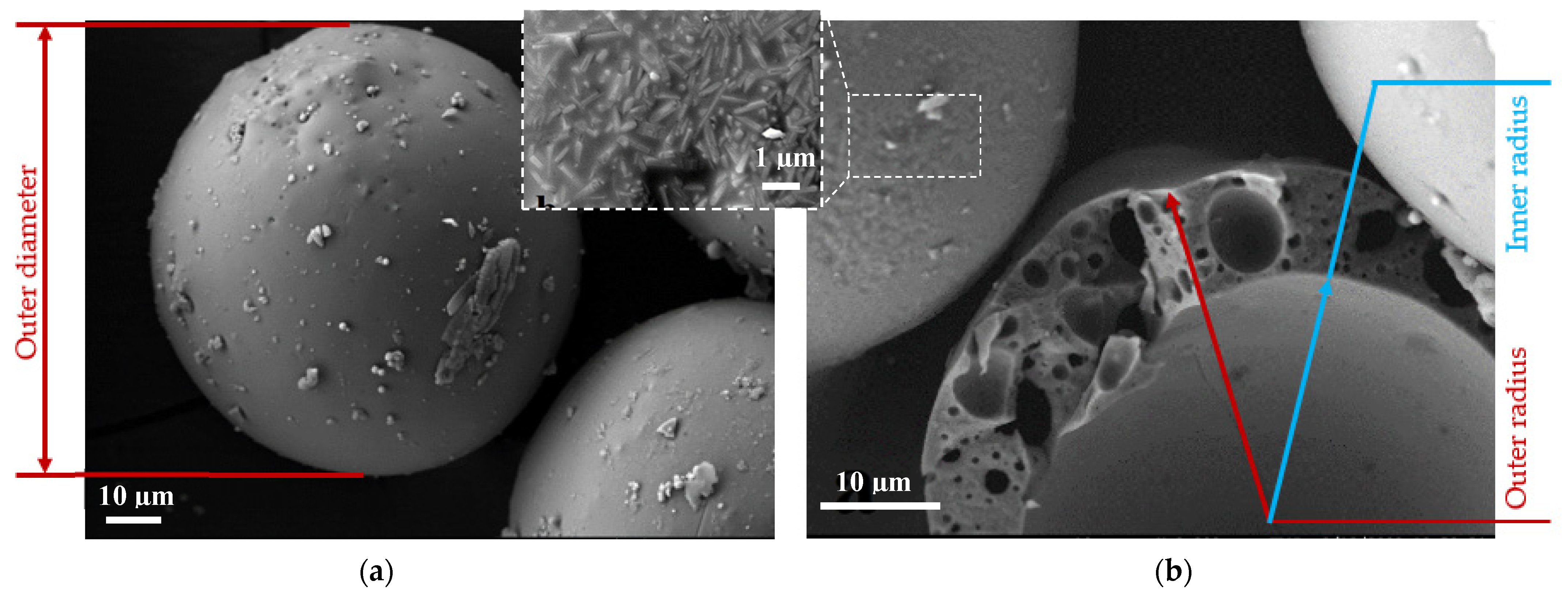
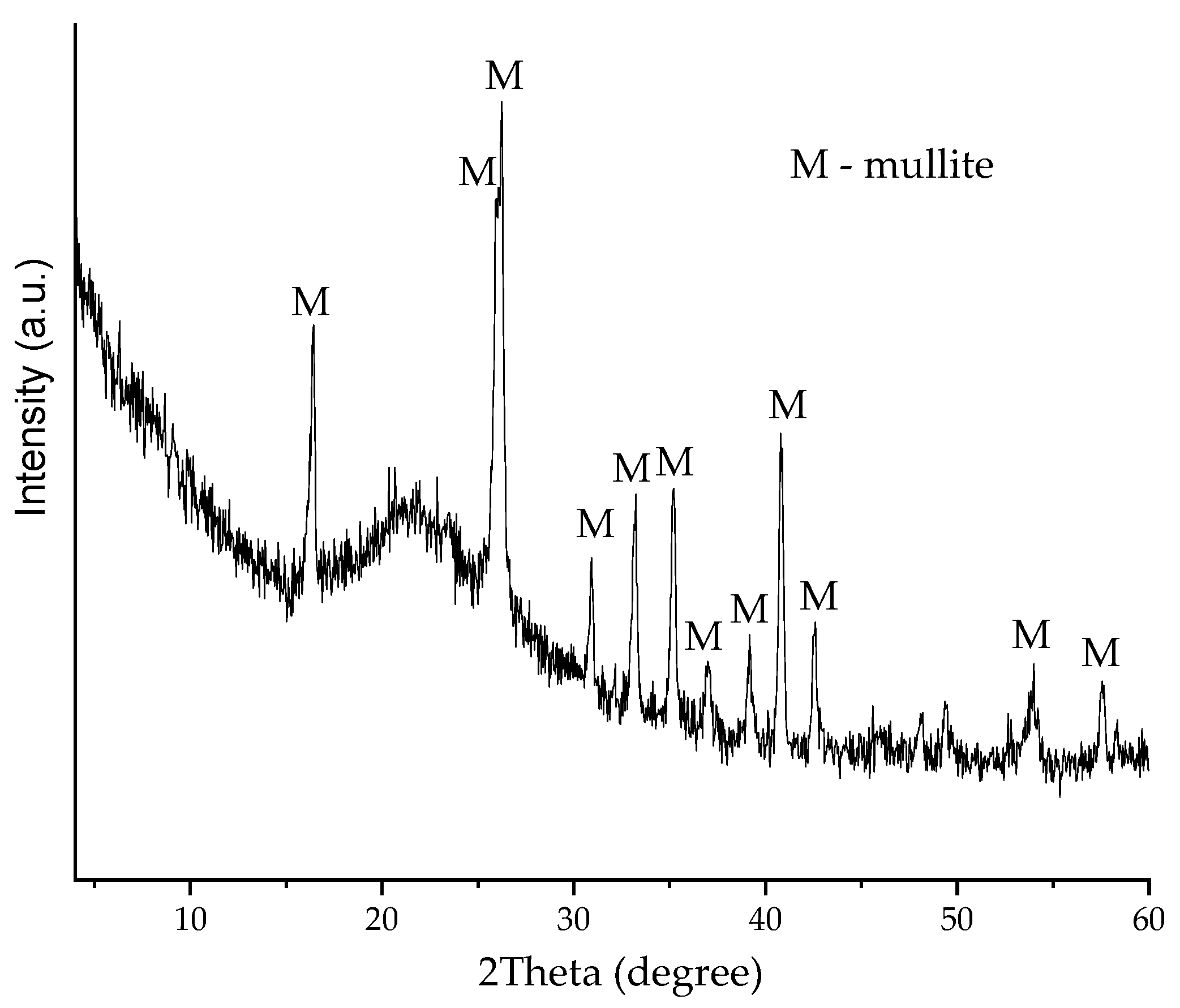
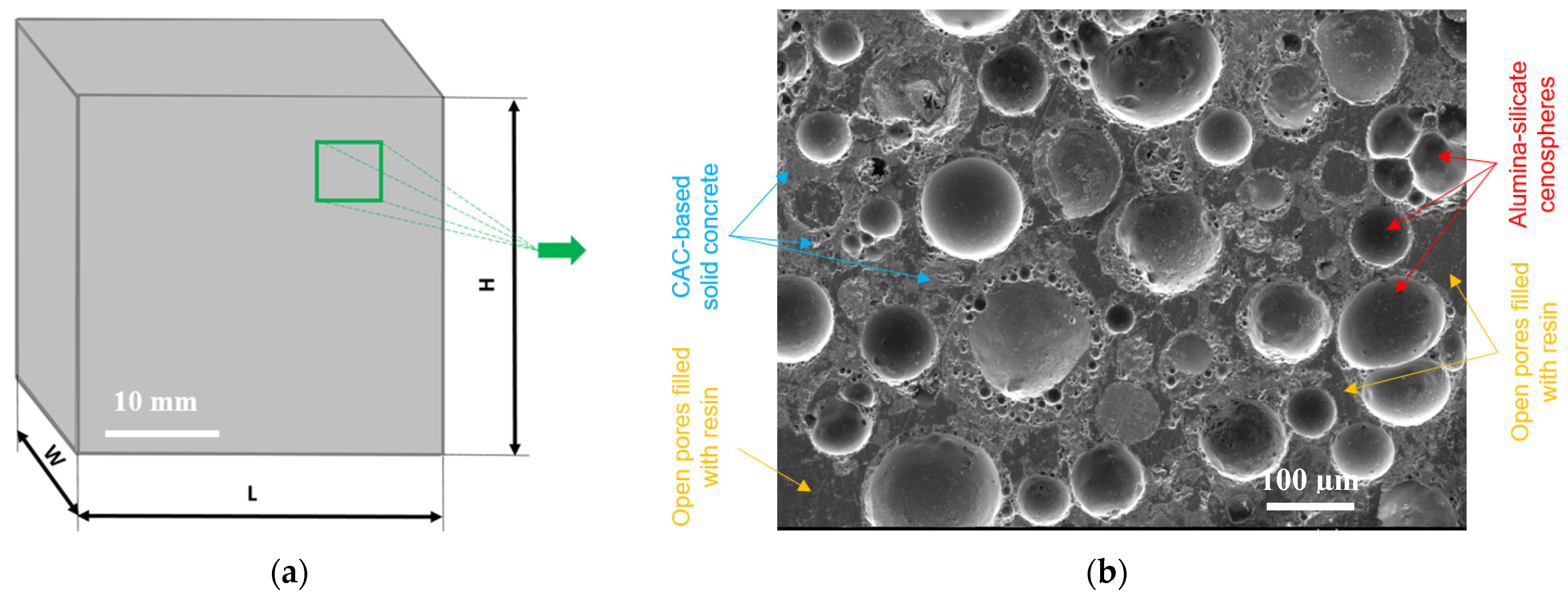
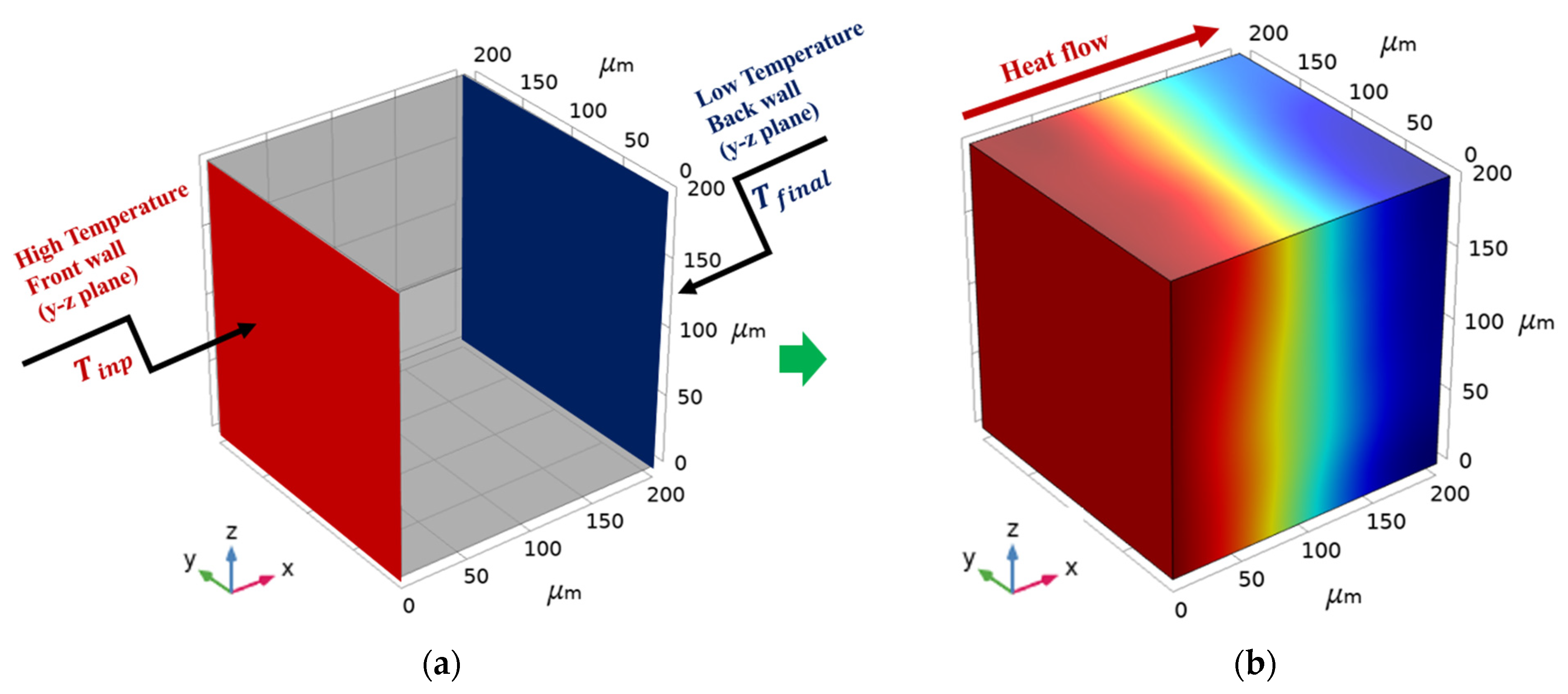
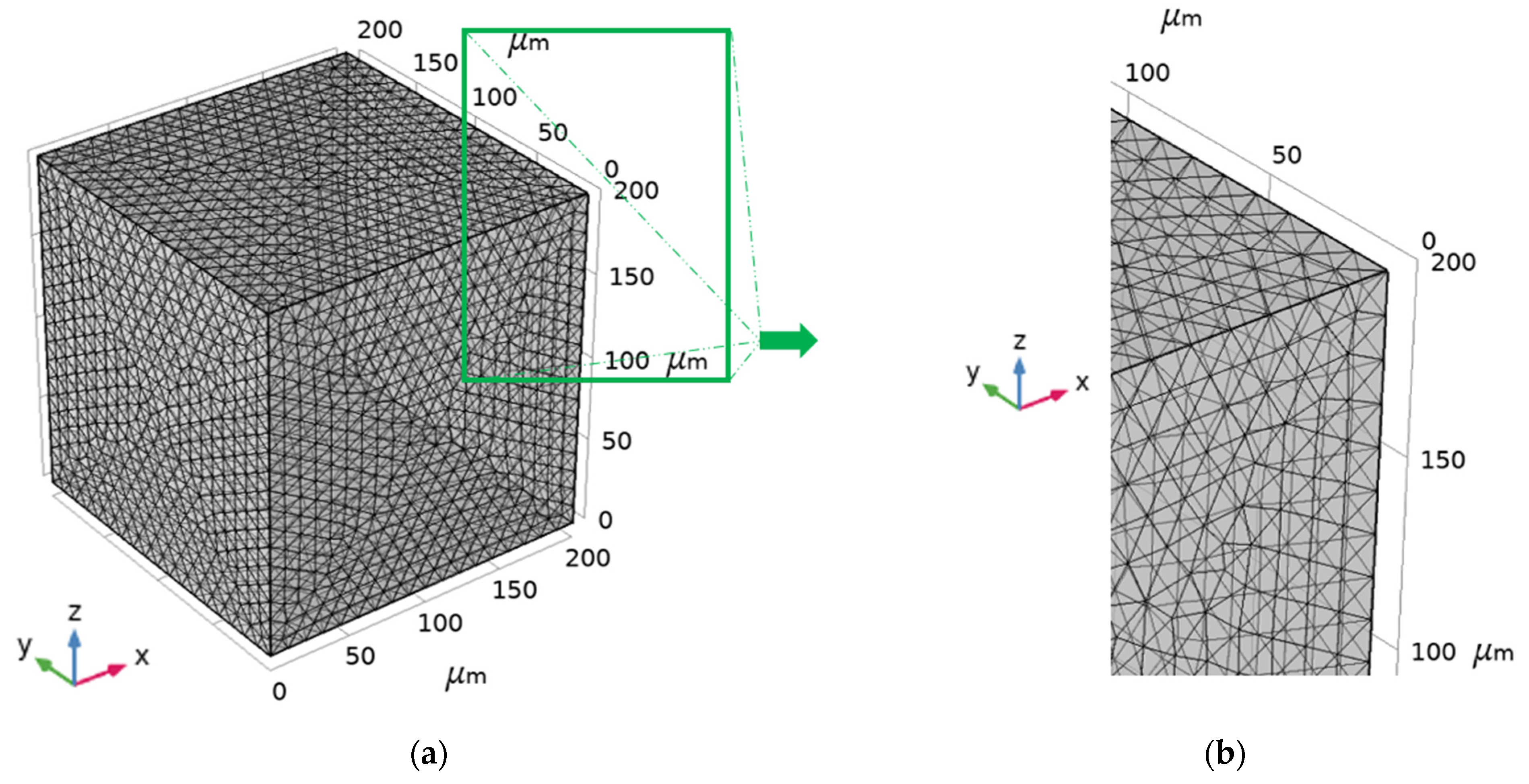
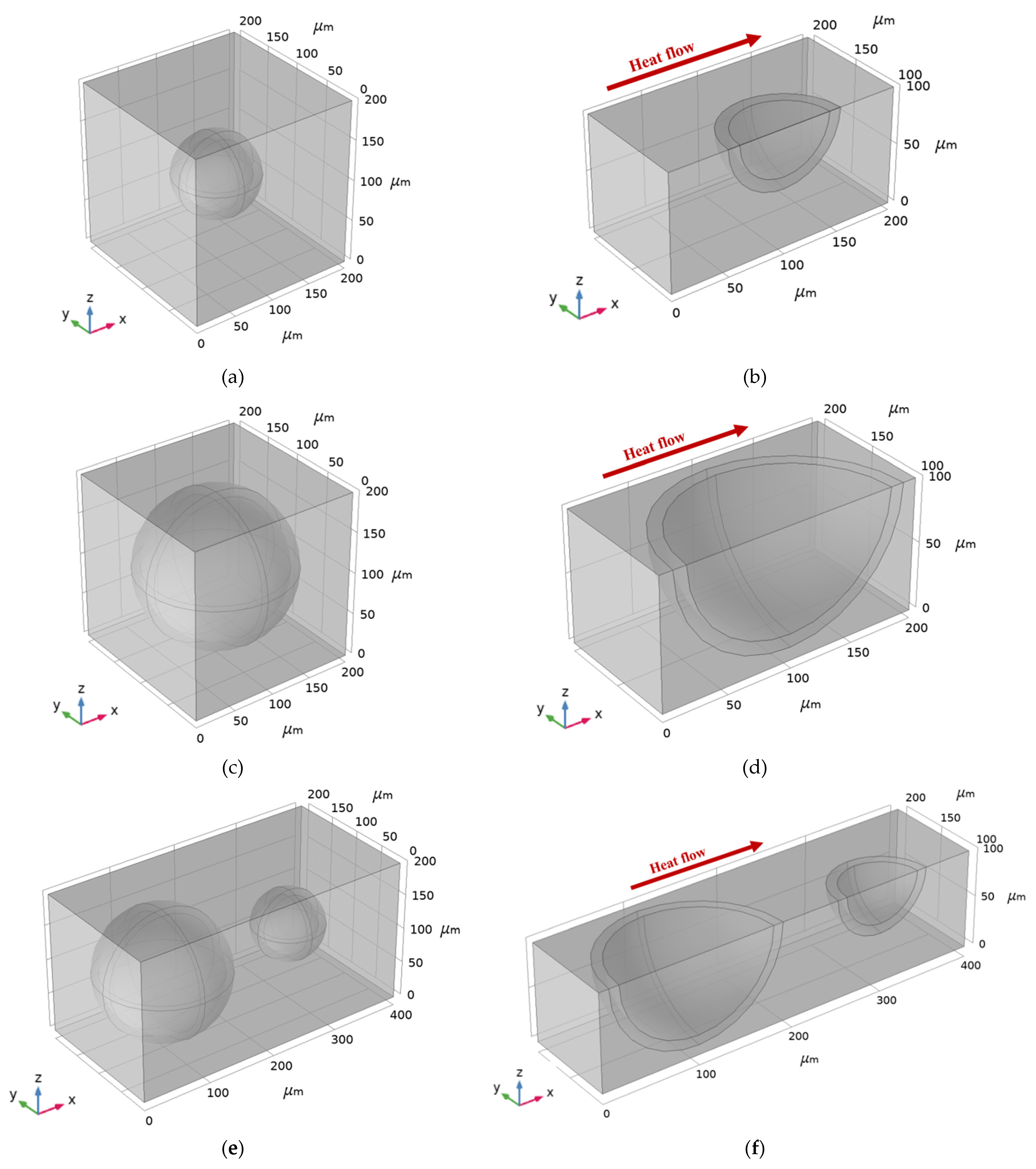
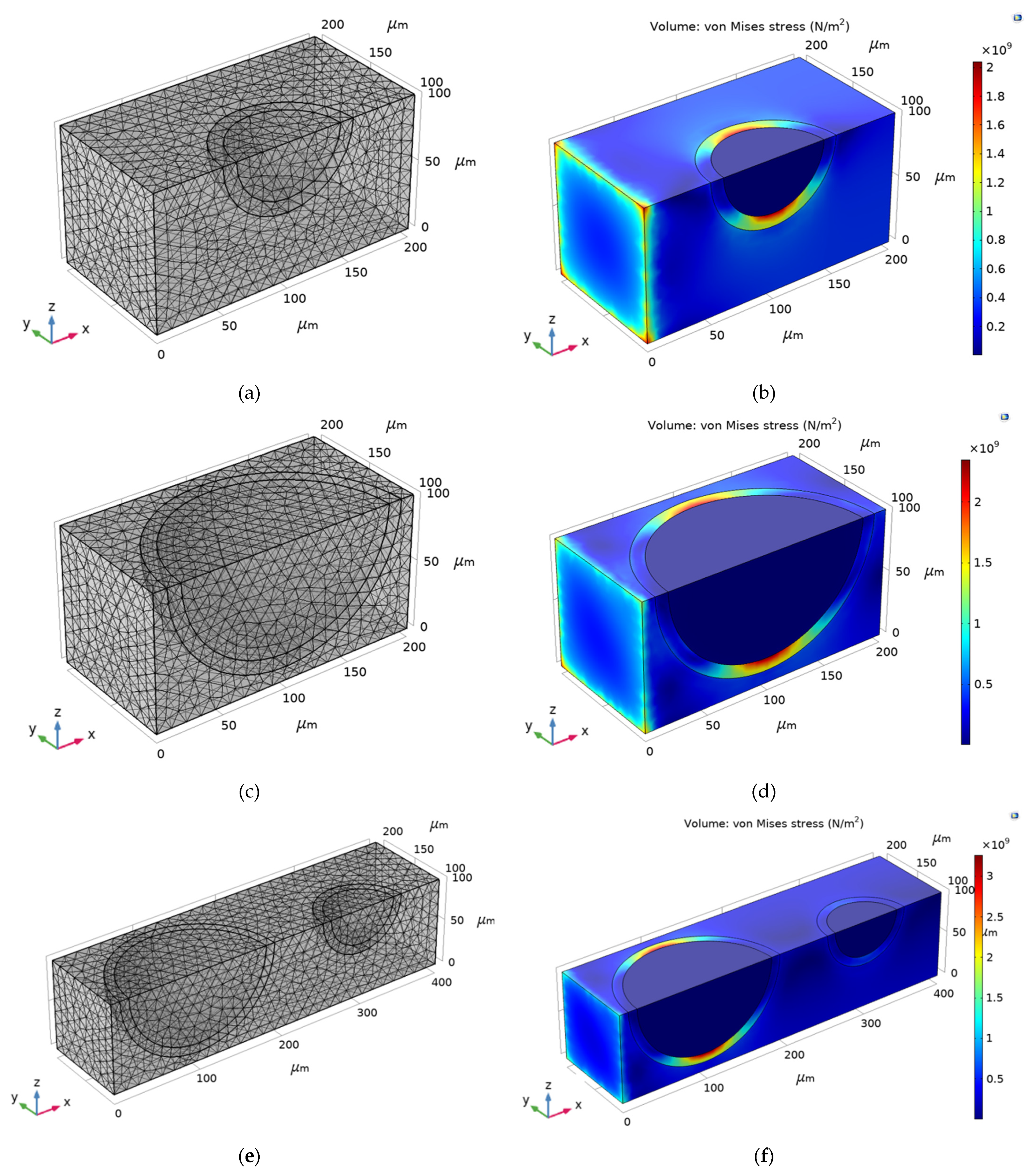

| Material | Amount, % of Mass |
|---|---|
| Calcium aluminate cement Górkal 70 | 35 |
| Aluminosilicate cenospheres | 65 |
| Water | 55 |
| Homogeneous Material | Density, | Heat Capacity at Constant Pressure, | Thermal Conductivity, |
|---|---|---|---|
| MHM1 | 3030.00 | 682.00 | 2.00 |
| MHM2 | 2300.00 | 880.00 | 0.60 |
| MHM3 | 0.20 | 1200.00 | 0.09 |
| Material | Cenosphere Shell (Aluminosilicate) | Calcium Aluminate Cement (CAC) | Air | Simulated Values (Equation (3)) | Effective Values (Analytical) | |||
|---|---|---|---|---|---|---|---|---|
| MHM1 | 2.00 | 1 | - | - | - | - | 2.00 | - |
| MHM2 | - | - | 0.60 | 1 | - | - | 0.61 | - |
| MHM3 | - | - | - | - | 0.09 | 1 | 0.09 | - |
| Composite 1 | 2.00 | 0.0319 | 0.60 | 0.9346 | 0.09 | 0.0335 | 0.6274 | 0.6277 (Equation (1)) |
| Composite 2 | 2.00 | 0.1136 | 0.60 | 0.6183 | 0.09 | 0.2681 | 0.4215 | 0.4152 (Equation (2)) |
| Composite 3 | 2.00 | 0.0728 | 0.60 | 0.7764 | 0.09 | 0.1508 | 0.5218 | 0.5039 (Equation (3)) |
Disclaimer/Publisher’s Note: The statements, opinions and data contained in all publications are solely those of the individual author(s) and contributor(s) and not of MDPI and/or the editor(s). MDPI and/or the editor(s) disclaim responsibility for any injury to people or property resulting from any ideas, methods, instructions or products referred to in the content. |
© 2022 by the authors. Licensee MDPI, Basel, Switzerland. This article is an open access article distributed under the terms and conditions of the Creative Commons Attribution (CC BY) license (https://creativecommons.org/licenses/by/4.0/).
Share and Cite
Mačiūnas, D.; Nosewicz, S.; Kačianauskas, R.; Boris, R.; Stonys, R. Numerical Simulation of Thermal Conductivity and Thermal Stress in Lightweight Refractory Concrete with Cenospheres. Materials 2023, 16, 190. https://doi.org/10.3390/ma16010190
Mačiūnas D, Nosewicz S, Kačianauskas R, Boris R, Stonys R. Numerical Simulation of Thermal Conductivity and Thermal Stress in Lightweight Refractory Concrete with Cenospheres. Materials. 2023; 16(1):190. https://doi.org/10.3390/ma16010190
Chicago/Turabian StyleMačiūnas, Darius, Szymon Nosewicz, Rimantas Kačianauskas, Renata Boris, and Rimvydas Stonys. 2023. "Numerical Simulation of Thermal Conductivity and Thermal Stress in Lightweight Refractory Concrete with Cenospheres" Materials 16, no. 1: 190. https://doi.org/10.3390/ma16010190






